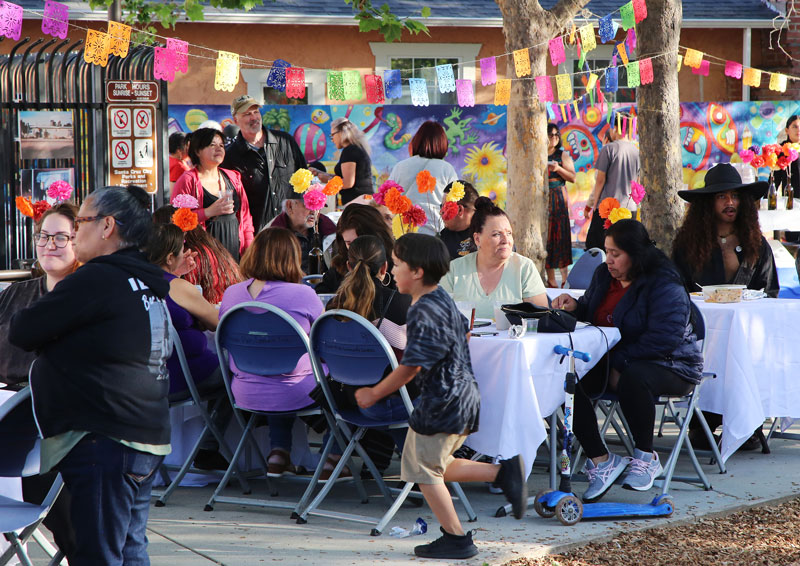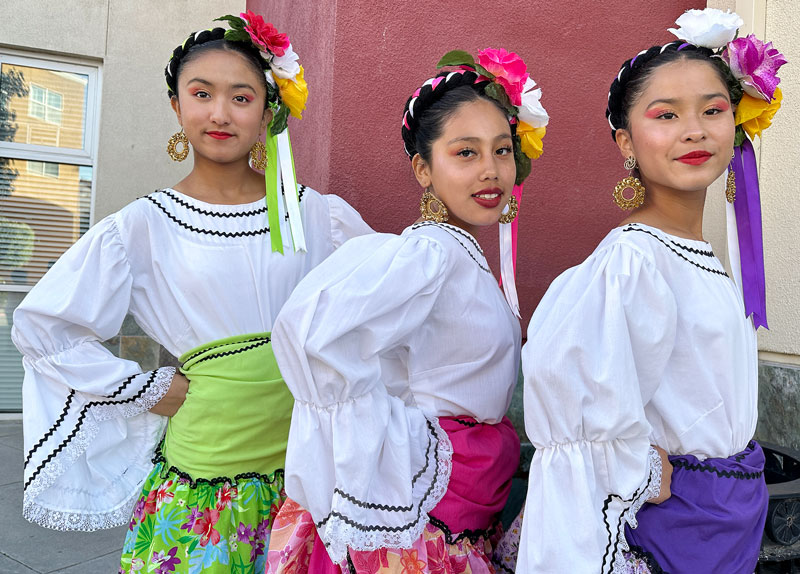The air is warm and thick with salt Friday evening at Beach Flats Park, just steps from the Boardwalk.
Three teenage girls from the Senderos nonprofit perform traditional Mexican dances, swirling their skirts to mariachi music in front of the Nueva Vista Community Resource Center at the neighborhood park. People gather around tables while kids run through the playground, all in celebration of the center hitting its 40th anniversary.
Like the community it serves, Nueva Vista Community Resources has endured challenges and persisted throughout the decades. Originally opened up as La Familia in 1983, the center provided crisis counseling and women’s medical services, among other things, to a low-income, high-crime community.
In 2008, when the center faced imminent closure, Community Bridges stepped in to keep it running. Now, it continues to ensure the Beach Flats and lower Ocean communities, Santa Cruz’s highest minority-concentrated neighborhoods, have access to things like clothes, food, counseling services and more.

one of Santa Cruz’s highest minority-concentrated neighborhoods. PHOTO: Tarmo Hannula
While Nueva Vista tries to fill in the gaps to support low-income residents to make ends meet, the neighborhood faces challenges beyond the scope of a resource center.
According to locals, the neighborhood’s longtime residents are increasingly at risk of relocation as the city continues to be mainly unaffordable to low-income families—despite that neighborhood being a haven for lower-cost housing throughout the past decades.
How did the Beach Flats and Ocean Street neighborhoods become the lower-income, minority neighborhoods in Santa Cruz? In an increasingly expensive city, what does the future of these neighborhoods look like?
BEACH FLATS HISTORY
When Eduardo Montesino, the now-mayor of Watsonville, recalls growing up in Beach Flats in the ’80s, a few things stand out to him.
He remembers people watching at the Boardwalk in the summer with his cousins, partly because of the limited access to green space. They walked around the bustling Boardwalk, occasionally stopping by the small park—what he described as a small square slab of concrete and dirt—to hang around.
Montesino remembers sharing a studio with his mother, father and siblings—and the cockroaches. He recalls the “cockroach bomb” they would set off in the house to kill the critters—a familiar neighborhood routine.
He remembers the walk from his neighborhood to where the downtown Trader Joes now stands, the closest grocery store to his home. And he recalls the prostitutes strolling the sidewalks in the evenings and drug deals happening on street corners.
“It was probably a very tough neighborhood,” Montesino says. “But as a kid, you never saw that because you didn’t have that broader context.”
It wasn’t always considered a tough neighborhood.
The Beach Flats neighborhood can be traced back to the beginning of the 20th century when the boardwalk was built in 1907. According to the book History & Future Of The Santa Cruz Waterfront: A Historic Perspective of the Wharf-Mouth, Beach Hill, Beach Street, Beach Flats, Depot District, And Riverside Park, written by local historian Eric Ross Gibson, by the 1920s, scores of families had built bungalows and cottages near the boardwalk as summer retreats. Grocery stores, restaurants and boat rentals soon followed.
The area remained popular until 1955 when, after a devastating flood, the Army Corps of Engineers built levees to protect the town. Gibson writes that this flood changed everything for the neighborhood, which was now less appealing to tourists as the ocean views were obstructed and access to the river changed. The neighborhood rental market dropped in value as landowners struggled to find people to fill their units.
Today, most of the rentals in the neighborhood are the same ones built before the flood, and the area is now made up of primarily lower-income, working-class minorities of Latin descent.
Santa Cruz Mayor Fred Keeley attributes the change in the makeup of this neighborhood in part to the accessibility of the wharf and Boardwalk.
“Many of the workers in the flats may be in the service industry, in the gardening industry or maybe working at professional jobs at the boardwalk,” Keeley says. “The proximity to many of the employment centers has historically drawn Latinx workers, many of whom have immigrated to the United States.”
According to many who live there and data from 2019, the neighborhood is home to most of the city’s service industry employees. For a town with a tourism tax that is estimated to bring in $12 million in revenue in 2023, these workers are essential to the economic vitality of Santa Cruz.
Assistant professor in Anthropology and Social Change Michelle Glowa, who has researched the Beach Flats neighborhood, says this neighborhood deserves the same rights and privileges as other parts of the city.
“This isn’t the doormat to the tourists’ playground and the boardwalk,” Glowa says. “This is an important community. And these are our friends and neighbors who live here in Santa Cruz and should have every right to decide what their life and community look like.”
NEIGHBORHOOD CHALLENGES
Montesino, whose sister and mother still live in the neighborhood, says that when he visits, he notices that the area has changed in some ways from his childhood. It’s safer; there are fewer drugs and less prostitution; there has been clear investment in green spaces like the park and the community garden.
But some aspects have remained the same. From accounts Montesino has heard, conditions of many of the homes in the Ocean and Beach Flats neighborhoods are uninhabitable: mold, lead contamination and the simple wear and tear that comes from cottages and bungalows remaining from the early 1900s. Still, longtime residents are being pushed out of the neighborhood because of rising rent costs.
“I have a longtime family friend; he had to move out to Watsonville,” Montesino says. “He works at a restaurant in the wharf and originally lived in Santa Cruz for many years. But it just became unaffordable, and there’s not enough space.”
Glowa’s research reinforces this anecdote on a larger scale. In 2015 during her graduate program, she worked with UCSC students to survey residents about what they viewed as their primary concerns and challenges. The top concerns included neglectful landlords, poor living conditions and displacement due to high rent and lack of green space.
“It’s a different context from now, but today there are still many of the same concerns, if not even more exacerbated,” Glowa says.
It will be critical, Glowa adds, that as the city tries to address any affordability issues, it prioritizes the voices of the residents who live there now to avoid residents being priced out of their homes.
“It’s a concern that when housing gets improved, that can benefit neighbors and community, and it can also be a process that leads to some displacement,” she says. “Unless you have strong advocacy from those tenants, they can stay in their neighborhood and where they’ve been living. [The city needs to] make sure to have tenants’ voices at the table and empower tenants to be a part of the development process.”
LOOKING AHEAD
Keeley admits that the Beach Flats neighborhood has been neglected in previous years.
“It’s in an area that could be relatively easily flooded,” Keeley says. “It’s a neighborhood somewhat noisier than the rest of the community because it’s immediately adjacent to the boardwalk and all its activity. It is densely populated, and the neighborhood streets are relatively narrow. It’s a neighborhood that, over the decades, has, in my judgment, been treated differently. I think that’s changed over the past years.”
And it will continue to change, he says. Keeley points to the city’s shift to district elections, which ideally will hold representatives accountable for the interests of the neighborhoods they represent. He also says that the city’s upcoming housing mandates from the state will bring an influx of affordable housing units that will help offset rising rents.
A transformation plan for the neighborhood is also in the works. The city is just in the beginning stages of the project, collecting community input from the residents in the neighborhood.
But, he says, there will be an upcoming community meeting this Thursday to design and build an affordable housing bond measure that will be placed on the 2024 ballot. Keeley also attended the Nueva Vista anniversary party, where he told community members about the chance to give feedback on the bond measure, so he expects input from the Beach Flats neighborhood.
“I think we have an opportunity to focus on a range of housing affordability as we’re complying with state law,” Keeley says. “There will be, by law, more extremely low, very low, low, and moderate-income units by a lot. We will see a rather major transformation of downtown Santa Cruz. I think that increasing housing, which is affordable in this strategy, will be helpful to Beach Flats residents.”














“A transformation plan for the neighborhood ” – that sounds like gentrification to me, which always displaces current residents. Or, a 7-story residential tower. On a flood plain. Call me skeptical. And why bring up an affordable housing bond for 2024, if it will most likely do nothing for Beach Flats families?